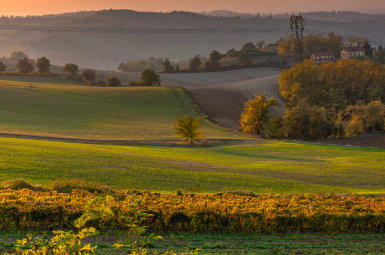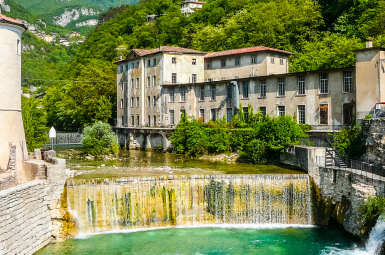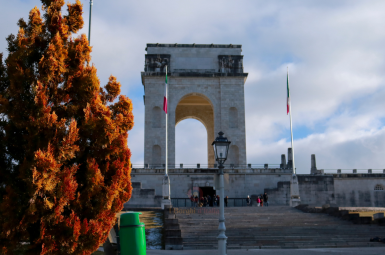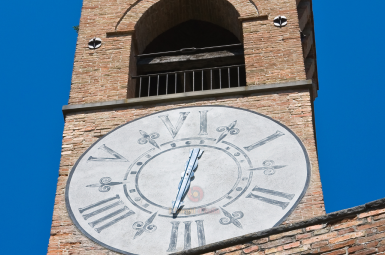
Montechiarugolo
Il Borgo di Montechiarugolo
Il Castello: Fortezza e Corte Rinascimentale
Il cuore incontrastato del borgo è il Castello di Montechiarugolo, una struttura che ha saputo evolvere da baluardo difensivo a raffinata dimora signorile, soprattutto sotto l’illuminata guida di Pomponio Torelli nel Cinquecento.- Architettura e Splendore: Nonostante le sue origini medievali, il Castello fu trasformato in una vera e propria corte intellettuale e residenza di caratura europea. L’interno sfoggia un notevole ciclo di affreschi di pregio, in particolare quelli commissionati a Cesare Baglione e alla sua scuola, che conferiscono alle sale un’atmosfera elegante e colta.
- Capolavori Nascosti: Tra gli spazi più significativi, spiccano il Salone delle Feste con i suoi stemmi e la Camera di Mezzo, dove si trova l’opera pittorica dell’Annunciazione di gusto gotico-lombardo.
- Storia Viva: Le sue mura furono testimoni di eventi cruciali, ospitando personaggi come Papa Paolo III e il re di Francia Francesco I, e furono teatro del primo scontro del Risorgimento nel 1796.
La Leggenda della Fata Bema: Il Fantasma Protettore
Come ogni maniero che si rispetti, il Castello di Montechiarugolo custodisce un mistero affascinante: la leggenda della Fata Bema. Bema, una giovane indovina, visse a corte ed è legata a una tragica profezia d’amore e morte per il suo amato Pio Torelli.- Il Mito: Si narra che il fantasma benefico della Fata Bema si manifesti ancora oggi, specialmente il 19 maggio (anniversario della morte di Pio Torelli), per proteggere il maniero e presagire eventi futuri. La piccola Saletta della Fata Bema conserva un’antica mummia egizia che la tradizione vuole sia il suo corpo.
Un Territorio di Gusto e Natura
Montechiarugolo si trova in una posizione strategica, a cavallo tra Parma e Reggio Emilia, immersa in un paesaggio di dolci colline e pianura fluviale.- Enogastronomia: Il territorio è un punto nevralgico della Food Valley, rientrando nell’area di produzione del celebre Prosciutto di Parma DOP e dei Vini dei Colli. Non lontano si trovano anche le moderne e rinomate strutture di Monticelli Terme, che aggiungono un tocco di relax e benessere all’offerta culturale.
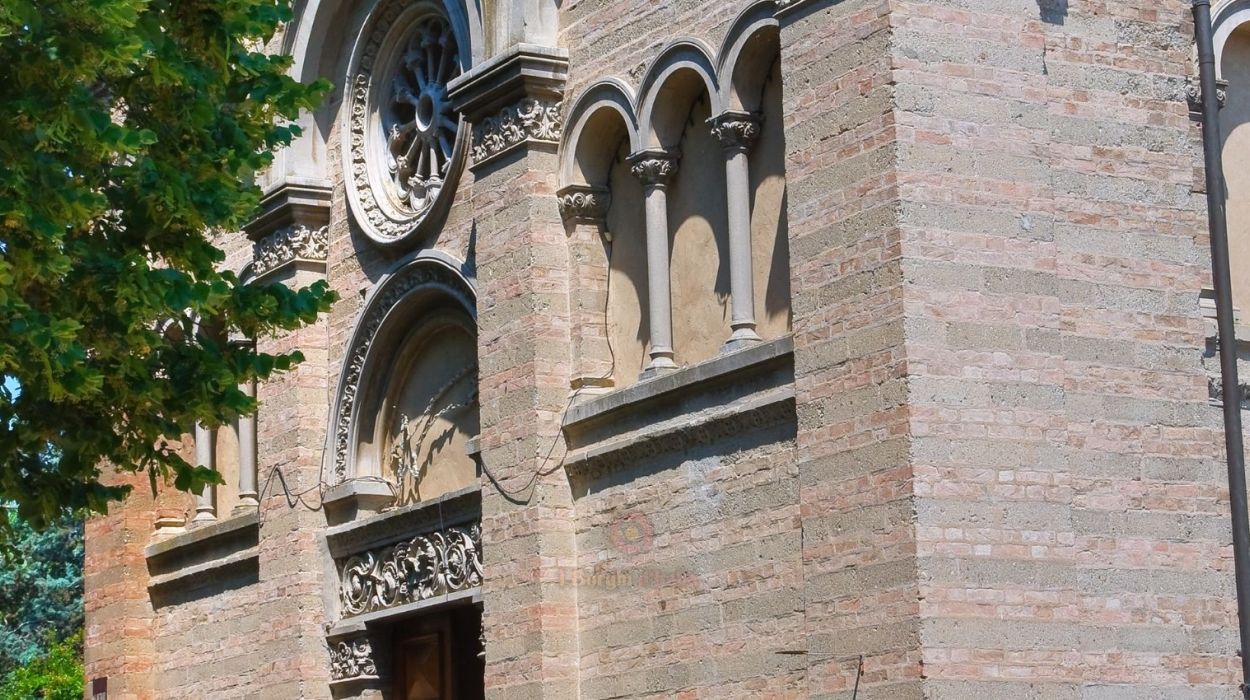
Il Borgo d’Italia
tutto da scoprire ed esplorare
Monumenti
Montechiarugolo: Quando la Storia Indossa il Velo del Mistero
Montechiarugolo non è un semplice borgo emiliano; è una sintesi perfetta tra l’imponenza medievale e l’eleganza rinascimentale, un luogo dove la storia e la leggenda si fondono in monumenti che raccontano secoli di intrighi e fascino.
Il Castello di Montechiarugolo: Fortezza e Corte Rinascimentale
Dominando la riva sinistra del torrente Enza, in una posizione strategica di confine, il Castello di Montechiarugolo è il cuore pulsante del paese e uno degli esempi più affascinanti di maniero italiano.
- Dalle Mura Ghibelline all’Eleganza: Nato come fortezza strategica nel XII secolo, fu la potente famiglia Torelli (proprietaria dal ‘400) a trasformarlo. In particolare, sotto il colto umanista e letterato Pomponio Torelli nel Cinquecento, la struttura divenne una vera e propria corte rinascimentale, ospitando personaggi illustri come il Re di Francia Francesco I e Papa Paolo III.
- Capolavori Nascosti: All’interno, le sale di rappresentanza rivelano tesori artistici: il magnifico Salone delle Feste e soprattutto la Camera Pinta affrescata da Cesare Baglione e dalla sua scuola, con allegorie che celebrano il potere e la cultura del casato. Da non perdere il loggiato quattrocentesco con il suo grande stemma.
- La Leggenda della Fata Bema: A rendere unico il Castello è il suo misterioso spirito protettore, la Fata Bema. Nota per le sue doti divinatorie, fu imprigionata dopo aver predetto un destino tragico. La leggenda vuole che il suo spirito appaia ancora oggi, in particolare il 19 maggio (anniversario della morte del suo amato Pio Torelli), per proteggere le giovani spose del borgo. Addirittura, in una saletta si conserva una mummia egizia che, secondo la tradizione popolare, apparterrebbe proprio alla Fata.
La Chiesa di San Quintino: Neoromanico e Affreschi Antichi
A pochi passi dal Castello sorge la Chiesa Parrocchiale di San Quintino, un punto di riferimento spirituale e artistico.
- Una Ricostruzione Storica: Menzionata per la prima volta nel XII secolo, la chiesa originale era di stampo romanico. Gran parte dell’attuale edificio è frutto di una quasi totale ricostruzione in stile neoromanico avvenuta tra il 1901 e il 1910, che ha però conservato della struttura precedente l’abside e il campanile.
- L’Oratorio Nascosto: Nonostante le modifiche, la chiesa custodisce un importante tesoro artistico: nell’ambiente a sud del presbiterio sono stati riportati alla luce affreschi tardo-quattrocenteschi che raffigurano la Madonna della Misericordia, commissionata nel 1483 dal conte Marsilio Torelli, testimoniando l’antichità e l’influenza della famiglia dominante anche sulla vita religiosa del borgo.
Il Monumento ai Caduti: Memoria e Identità
A completare il quadro storico-monumentale di Montechiarugolo si trova il Monumento ai Caduti delle Guerre Mondiali. Sebbene sia un’opera più recente rispetto al Castello, svolge un ruolo cruciale nel tessuto sociale del paese.
- Omaggio al Sacrificio: Realizzato originariamente per commemorare i caduti della Prima Guerra Mondiale, fu successivamente integrato con una lapide in ricordo delle vittime del secondo conflitto, fungendo da costante richiamo al sacrificio e all’identità civica della comunità.
La visita a Montechiarugolo è un viaggio obbligato per chi cerca la storia autentica, l’architettura imponente e l’eco di leggende secolari, tutte custodite in un borgo che mantiene intatto il suo fascino.
Curiosità
Montechiarugolo: Quando la Storia Bussa alla Porta e la Magia Incontra le Acque
Montechiarugolo non è solo un borgo dominato da un magnifico Castello: è un crocevia di leggende, un luogo che ha segnato l’inizio del Risorgimento italiano e una moderna oasi di benessere. Ecco le curiosità che rendono questo paese, alle porte di Parma, un luogo davvero unico.
Il Mistero della Fata Bema: Amore, Profezie e un Fantasma
Il Castello di Montechiarugolo non sarebbe lo stesso senza la sua leggenda più affascinante, quella della Fata Bema.
- La Bella Vistamare: Bema era una giovane donna dotata di incredibili poteri divinatori, capace di leggere il futuro e dare consigli. Fu ospitata a corte dai Torelli e si innamorò del Conte Pio, ma il suo destino fu segnato da una funesta profezia.
- La Tragedia e il Ritorno: Si narra che Bema predisse la congiura e la morte di Pio Torelli, avvenuta il 19 maggio 1612. Nonostante la sua fine serena (secondo alcune versioni), la leggenda vuole che il suo spirito appaia ogni anno nella notte tra il 18 e il 19 maggio.
- La Mummia nel Castello: All’interno del maniero, in una piccola e suggestiva saletta, è conservata una mummia egizia. La tradizione popolare, nel suo intreccio di storia e mito, vuole che si tratti proprio del corpo della Fata Bema, lasciando ai visitatori un brivido di mistero irrisolto.
La Culla del Risorgimento: La Battaglia Dimenticata
Montechiarugolo è un luogo cruciale nella storia dell’Unità d’Italia, ben prima delle grandi battaglie del XIX secolo.
- Il Primo Scontro: Il 4 ottobre 1796 il borgo fu teatro della Battaglia di Montechiarugolo, il primo episodio d’armi del Risorgimento italiano. Milizie volontarie della Guardia Civica Reggiana, affiancate da soldati francesi, attaccarono un manipolo di truppe austriache rifugiatesi nel Castello.
- L’Elogio di Napoleone: Lo scontro, pur breve e con pochi caduti, ebbe un’enorme risonanza. Fu tanto significativo che lo stesso Napoleone Bonaparte volle lodare l’impresa, definendo i patrioti caduti come “i primi che avevano versato il loro sangue per la libertà”. Un riconoscimento che sottolinea il ruolo pionieristico di questo piccolo borgo.
Monticelli Terme: Acque d’Oro e Benessere
Una frazione del Comune, Monticelli Terme, è rinomata a livello nazionale per le proprietà curative delle sue acque.
- Una Scoperta Casuale: La vocazione termale di Monticelli è relativamente moderna. Le acque furono scoperte nel XX secolo, inizialmente durante la ricerca di acqua per l’irrigazione. Si rivelarono invece ricche di proprietà salsobromoiodiche e sulfuree.
- Acque Salinissime: Le acque salsobromoiodiche di Monticelli sono eccezionalmente concentrate, con una salinità che può essere fino a tre volte superiore a quella del Mar Mediterraneo, rendendole preziose per trattamenti curativi e di benessere.
Montechiarugolo offre così un’esperienza completa: dalla maestosità medievale alle memorie risorgimentali, fino alla moderna ricerca di relax nelle sue acque termali.
Personaggi
Montechiarugolo: Dalla Nobiltà Letterata ai Padri della Città Moderna
Montechiarugolo non è solo un borgo di imponente bellezza storica; è la culla di figure che hanno lasciato un segno profondo nella cultura, nella politica e nell’imprenditoria tra il Rinascimento e l’epoca moderna. Le sue personalità più illustri hanno plasmato l’identità del territorio e oltre.
Pomponio Torelli (1539-1608): L’Umanista del Castello
La figura più emblematica legata a Montechiarugolo è senza dubbio il conte Pomponio Torelli, rampollo della famiglia che per secoli ha dominato il Castello.
- Letterato e Tragediografo: Nato proprio nel maniero di famiglia nel 1539, Pomponio fu un insigne umanista e letterato. È considerato il più importante tragediografo italiano di fine Cinquecento, con opere influenti come Merope e Tancredi. Le sue tragedie, focalizzate sul conflitto tra Ragion di Stato e affetti individuali, anticiparono temi del Settecento.
- Mecenate e Diplomatico: Fu lui a trasformare la fortezza medievale nel raffinato palazzo rinascimentale che ammiriamo oggi, facendone una vera e propria corte frequentata da artisti e ospiti illustri. Svolse anche importanti incarichi diplomatici al servizio dei Duchi Farnese di Parma, testimoniando un’influenza che andava ben oltre i confini del suo feudo.
Giovanni Mariotti (1850-1935): Il Sindaco Costruttore
Montechiarugolo vanta tra i suoi nativi anche un grande protagonista della vita politica e amministrativa parmense tra Otto e Novecento: Giovanni Mariotti.
- Dalle Origini al Governo della Città: Mariotti trascorse l’infanzia e l’adolescenza tra Parma e la villa di famiglia a Montechiarugolo, dove iniziò la sua carriera civica giovanissimo, ricoprendo la carica di Sindaco del piccolo Comune già nel 1872.
- Il Modernizzatore di Parma: La sua influenza crebbe esponenzialmente, portandolo a diventare il Sindaco di Parma per ben quindici anni (in diversi mandati tra il 1889 e il 1914). Fu un vero e proprio “sindaco costruttore”, responsabile di importanti opere pubbliche che modernizzarono la città, come la costruzione di nuovi ponti, l’acquedotto e il completamento del Lungoparma.
- Cultura e Politica Nazionale: Fu anche Deputato e Senatore del Regno d’Italia e, parallelamente alla carriera politica, coltivò la sua passione per l’archeologia, subentrando nella direzione del Museo di Antichità di Parma.
Italo Borrini (e Famiglia): Il Padre delle Terme
Nella frazione di Monticelli, il nome di Italo Borrini è indissolubilmente legato alla trasformazione del territorio.
- La Fortuna dal Sottosuolo: Borrini è l’imprenditore che, all’inizio del XX secolo, scoprì fortuitamente le eccezionali acque salsobromoiodiche nel sottosuolo di Monticelli, mentre cercava acqua per l’irrigazione.
- Il Sognatore del Benessere: La sua visione imprenditoriale lo portò a fondare le Terme Borrini negli anni ’20, trasformando radicalmente il borgo agricolo in una rinomata stazione termale. A lui si deve la realizzazione degli stabilimenti in stile Liberty e la creazione del vasto parco termale, gettando le basi per l’odierna Monticelli Terme, punto di riferimento per la salute e il benessere.
Queste figure, pur distanti nel tempo, rappresentano la ricchezza e la poliedricità del patrimonio di Montechiarugolo, tra potere, arte, politica e innovazione.
Ricette Tipiche
I Sapori della Val d’Enza: L’Eredità Culinaria di Montechiarugolo
Immersa nel cuore della Food Valley parmense, Montechiarugolo è molto più di un borgo storico; è un autentico santuario del gusto, dove la vicinanza a Parma e il confine con Reggio Emilia si fondono in una tradizione gastronomica ricca e inconfondibile. Le ricette tipiche di quest’area sono un inno alla pasta fresca, ai salumi ineguagliabili e ai prodotti di eccellenza.
I Capolavori della Pasta Ripiena
Nessuna tavola emiliana è completa senza l’apoteosi della pasta fresca. A Montechiarugolo, questo si traduce in vere e proprie opere d’arte tramandate di rezdora in rezdora.
- Tortelli d’Erbetta (alla Parmigiana): Sono il piatto iconico e irrinunciabile, specialmente nella tradizionale “Tortellata di San Giovanni”. Il ripieno è un equilibrio delicato di ricotta, erbette (o spinaci), noce moscata e abbondante Parmigiano Reggiano. Vengono serviti semplicemente e gloriosamente con una generosa colata di burro fuso e una spolverata extra di formaggio.
- Anolini in Brodo: Se i tortelli sono la celebrazione, gli anolini sono il calore della festa, tipici del Natale e dei giorni speciali. Questi piccoli scrigni di pasta sottile sono ripieni in brodo di carne. Sebbene la ricetta parmigiana prediliga un ripieno a base di pane e Parmigiano, la vicinanza alla Bassa Padana li rende anche il perfetto accompagnamento per un brodo ricco e saporito, un vero abbraccio liquido.
- Tortelli di Zucca: Tipici dell’autunno, questi tortelli portano in tavola i sapori della terra. Il ripieno, dolce e speziato, unisce la zucca, gli amaretti sbriciolati e la mostarda, un contrasto che esalta la sapidità del condimento di burro e salvia.
I Fondamentali della Tradizione
La cucina di Montechiarugolo celebra la ricchezza del territorio in piatti che raccontano la storia contadina e la qualità delle materie prime locali.
- Torta Fritta e Salumi DOP: L’antipasto qui è un rito. La Torta Fritta (chiamata anche Gnocco Fritto o Pesto Fritto a seconda delle varianti locali) è una sfoglia di pasta “povera” fritta nello strutto, che si gonfia in un palloncino leggerissimo. È l’accompagnamento ideale per i giganti della salumeria: il Prosciutto di Parma DOP, il Culatello di Zibello, il Salame Felino e la Spalla Cotta di San Secondo.
- La Vecchia col Pesto di Cavallo: Piatto della più schietta tradizione parmense, consiste in un trito di carne di cavallo (il pesto), cotto in padella con cipolla e pomodoro, e servito su una base di patate lesse o fritte (la vecchia). Un sapore robusto e popolare, ancora oggi molto ricercato.
- Il Pomodoro: Una Vocazione Speciale: Montechiarugolo è un’area ad altissima vocazione per la coltivazione del pomodoro. La presenza di storiche aziende conserviere nella frazione di Basilicanova attesta l’eccellenza e l’importanza di questo ortaggio per l’economia e la cucina locale, che lo impiega in salse ricche per condire le tagliatelle al ragù e insaporire gli stracotti.
I Tesori Liquidi
Per accompagnare queste prelibatezze, il bicchiere non può che ospitare la tipicità del territorio:
- Vini dei Colli di Parma: I piatti robusti e saporiti trovano il loro match perfetto nei vini locali. Il Lambrusco Reggiano DOC, frizzante e rosso, è il compagno ideale per i salumi e i bolliti. Per i primi piatti, spiccano i bianchi aromatici dei Colli di Parma, come la Malvasia di Candia Aromatica, con la sua piacevole effervescenza e sentori fruttati.
